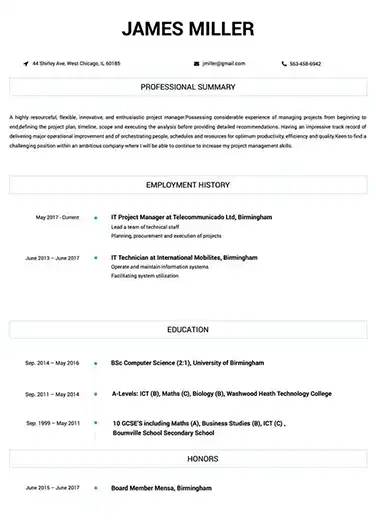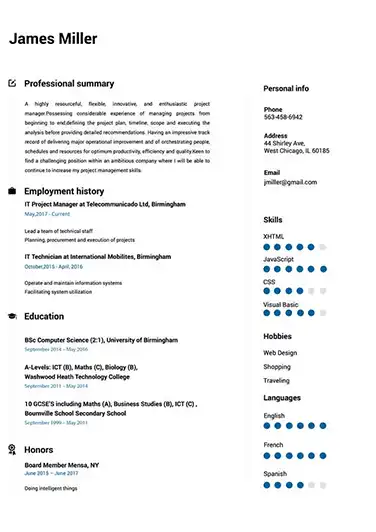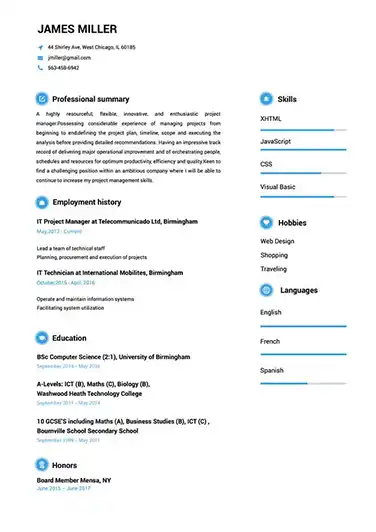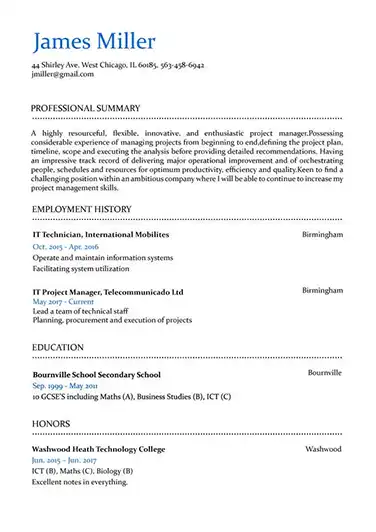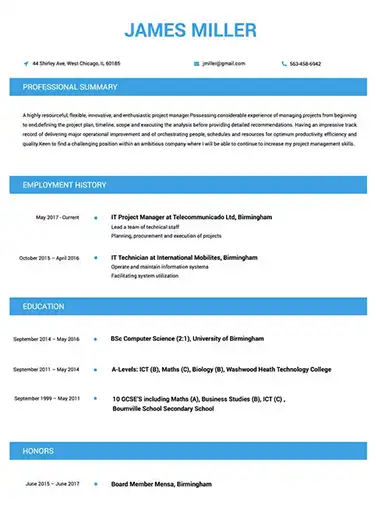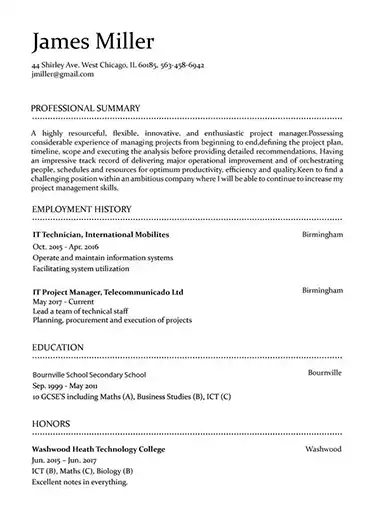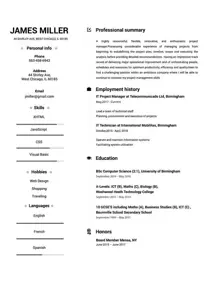 Use This Template
Use This Template
Build your resume in 15 minutes
Create an awesome resume that meets the expectations of potential employers with our selection of professional, field-tested resume templates.
physical therapy: Resume Samples & Writing Guide
austinrichard@gmail.com
721-866-7064
Employment history
- Educate patients on physical therapy techniques
- Evaluate patients to determine physical therapy needs
- Participate in continuing education programs to maintain licensure
- Assist with the development of physical therapy protocols
- Provide patient care in accordance with accepted standards of practice
- Assist with the development and implementation of patient care plans
- Evaluate patients to determine physical therapy needs
- Develop and implement patient-specific exercise programs
- Develop and implement physical therapy treatment plans
Education
Skills
Do you already have a resume? Use our PDF converter and edit your resume.
berniefoster@hotmail.com
735-015-7683
Employment history
- Participate in continuing education programs to maintain licensure
- Develop and implement physical therapy treatment plans
- Provide patient care in accordance with accepted standards of practice
Education
Skills
taylor.ulrich@yahoo.com
780-277-1675
Employment history
- Participate in continuing education programs to maintain licensure
- Maintain safe and clean working environment by adhering to established procedures, rules, and regulations
- Communicate with other healthcare professionals to coordinate patient care
- Participate in continuing education programs to maintain licensure
- Develop and implement patient-specific exercise programs
- Stay current with advances in physical therapy techniques
- Evaluate patients to determine physical therapy needs
- Provide patient education and instruction on proper use of therapeutic equipment
- Communicate with other healthcare professionals to coordinate patient care
Education
Skills
larryyates15@aol.com
607-100-1494
Employment history
- Assist with the development of physical therapy protocols
- Educate patients on physical therapy techniques
- Provide patient education and instruction on proper use of therapeutic equipment
- Assist with the development of physical therapy protocols
- Participate in continuing education programs to maintain licensure
- Provide patient care in accordance with accepted standards of practice
- Perform administrative duties such as documenting patient information and maintaining patient records
- Develop and implement patient-specific exercise programs
- Maintain safe and clean working environment by adhering to established procedures, rules, and regulations
Education
Skills
andersonnorman@aol.com
658-967-4556
Professional Summary
Employment history
- Administer and monitor physical therapy treatments
- Develop and implement patient-specific exercise programs
- Provide patient education and instruction on proper use of therapeutic equipment
- Educate patients on physical therapy techniques
- Provide patient education and instruction on proper use of therapeutic equipment
- Assist with the development of physical therapy protocols
- Perform administrative duties such as documenting patient information and maintaining patient records
- Assist with the development and implementation of patient care plans
- Communicate with other healthcare professionals to coordinate patient care
Education
Skills
Not in love with this template? Browse our full library of resume templates
According to the American Physical Therapy Association (APTA), physical therapists, also known as PTs, “are movement experts who improve quality of life through prescribed exercise, hands-on care, and patient education.” The association explains that PTs diagnose and treat individuals of all ages, including those with injuries, disabilities, or other health conditions that need treatment, as well as anyone who simply wants to improve their health in an effort to prevent future problems.
It’s no doubt a profession that requires considerable training, skill, and dedication to excel in. It’s great news, then, that the future looks bright for PTs. The Bureau of Labor Statistics (BLS) projects that employment of physical therapists will grow by 22 percent from 2018 to 2028, which is considerably faster than the 5 percent average for all occupations.
With an average of 16,900 job openings projected each year over the decade, it may certainly be tempting to send out as many job applications as possible using the same resume. After all, with so many jobs to go around, a pretty solid resume is enough to score one of them, right?
Not necessarily. The job market for PTs is still highly competitive, particularly for stable jobs at reputable companies. It’s also worth keeping in mind that wages can vary significantly in the industry. The median annual wage for physical therapists is quite high at approximately $89,000, however, the lowest 10 percent earn less than around $62,000, while the highest 10 percent earn more than double this. So if you’re gunning for a higher paying job, you can expect competition to be even stiffer than usual.
So what should you do if you’re a PT who’s on the job hunt grind? Boost your chances of getting hired by crafting a strong physical therapy resume. If you don’t have a clue where to begin, check out our comprehensive physical therapy resume guide below. It will shed a light on everything you’re unsure about including:
- The best format for your resume
- Which skills you should hone in on
- What to do if you’re just starting out in the profession
- How to make your resume more appealing to recruiters
- Whether there’s an alternative to spending hours making your resume
1. Multiple Template Examples
2. How to Write a Physical Therapist (PT) Resume That Will Get You Noticed by Recruiters
The ideal layout and format of a PT resume
Creating a physical therapy resume that catches the attention of recruiters requires you to get both its layout and formatting just right. Unfortunately, good enough isn’t going to cut it because the majority of recruiters won’t even look at a resume with a subpar layout or format.
However, this isn’t something you need to stress about as long as you pay attention to our expert insights. For example, we strongly recommend following the layout guidelines we’ve listed below. We compiled them based on HR professionals’ general preferences about candidates’ resumes.
- Number of Pages: A maximum of one page.
- Fonts to Use: Legible fonts that convey professionalism. For example, Cambria and Garamond.
- Fonts to Avoid: Any fonts that look immature. For example, Markerfelt and Tempus Sans.
- Margins: 1 inch on all sides.
- Line Spacing: 1 or 1.15.
- Header size: 14-16 point size.
- Text size: 11-12 point size.
HR professionals also tend to have strong ideas about which resume format is most ideal. Most of them recommend physical therapists to structure their resume using a reverse-chronological format. The reason being that this format places strong emphasis on a candidates’ work history. Furthermore, it orders candidates’ jobs in a logical manner (namely, from most to least recent) which in turn makes for easy reading.
What should a physical therapist put on their resume?
A physical therapist needs to cover a number of bases in their resume. This is because a resume should act as an overview of the most relevant and exceptional attributes you can offer as a professional. To ensure that your resume includes all the vital details recruiters are seeking, make sure that it features the following standard sections:
- Contact Information: Your resume should open with your contact information. Make sure to include your name, number, home address, and email address. If you have one, it’s worthwhile to include your LinkedIn profile URL as well.
- Resume Objective or Resume Summary: A brief statement that conveys why you’re a strong candidate for the particular PT position you’re applying for.
- Employment History: An overview of your professional work history, focusing on your most relevant jobs.
- Education: Key details about your college degrees.
- Training and Certifications: A summary about any relevant training and certifications that allowed you to develop your knowledge and skills as a PT.
- Skills: A list of hard and soft skills you possess that directly relate to the ones a recruiter is after.
Pro tip: Double-check that your contact details are up to date and written correctly. You’d be surprised by just how many candidates can’t be properly contacted because they miswrote their email or phone number!
How to list your education as well as your license, training, and certifications
You’ll no doubt want to reassure a recruiter that you’re a well-rounded candidate. That’s why your resume needs to feature your educational background as well as your PT license and any relevant training and certifications you have to your name. There is a proper way to go about doing this, so don’t rush ahead without learning how. Below, we’ve outlined the best practices for including each of these pieces of information in your resume:
Education
There’s a reason physical therapists are considered to be highly-educated professionals – you’ll need a Doctor of Physical Therapy (DPT) to become one. But even before starting a DPT, you’ll need to complete your bachelor’s degree, either in physical therapy or a degree that covers the required prerequisites of a DPT.
To include your educational background in your resume, feature each degree in your “Education” section by listing the following information :
- The name of the degree
- The name of the college you attended
- The state the college is located in
- The years you studied
For example:
- Doctor of Physical Therapy (DPT), University of Oklahoma, OK, 2017 - 2020
- Bachelor of Science (Physics), Oklahoma State University, OK, 2013 - 2016
Pro tip: If you have any noteworthy educational achievements, such as the fact you graduated top of your class, you can include a few of them in bullet points under the respective degree.
License
It’s a requirement in all 50 states that PTs hold proper licensure before commencing work. Considering how critical your PLT license is, you’ll need to ensure a recruiter sees it in your resume. To feature it correctly, provide the following details about it in a dedicated “License” section:
- The name of the license (i.e. Physical Therapy License)
- The state you obtained it in
- Your license number
For example:
- Physical Therapy License, Oklahoma State, License Number: PT 71620
Training and certifications
Any relevant training and certifications you have as a physical therapist will be valuable to feature in your resume’s “Training and Certifications” section. There are two main types of certifications you should include:
- A board certification from The American Board of Physical Therapy Specialties (ABPTS) (if you have one)
- Other certifications that have a direct connection to the job you’re applying for
If you’re board certified with the ABPTS, be sure to put your certification at the top of your “Training and Certifications” section. Recruiters look favorably on board certified PTs – particularly if the certification is in the same specialty area the given job is in.
In regards to other certifications and training you have, it’s worth including any that would support you to perform the job you’re applying for. Don’t just feature internally and/or externally conducted industry training and certifications, either. Make sure to also include any first aid training you’ve undertaken.
To list your training and certifications, provide the following details:
- Name of the training or certification
- Name of the institution that administered it
- State the session or course was held in
- Year you received it
For example:
- Neurology Specialist Certification, American Board of Physical Therapy Specialties, NY, 2020
Which hard and soft skills should you mention on a resume?
It’s thanks to the skills you’ve developed over the years as a PT that you’re able to help so many individuals. So you’ll definitely want a recruiter to be assured of the fact that you’re a professional who boasts an enviable range of skills.
However, before you start adding skills to various sections of your resume, keep in mind that you need to select the most relevant skills you have to the job you’re applying for.
Luckily for you, there’s a tried-and-tested method you can use to work out what these skills are. This method basically involves identifying skills-focused ‘keywords’ in a job ad. Keywords is a term used to describe the words within a job ad that provide an insight into the qualities a recruiter is after according to their perception of an ideal candidate.
If you’re ready to learn how to identify skills-focused keywords (or any other keywords) in a job ad, read our handy 4-step guide:
- Pull up the job ad of the job you’re interested in.
- Scan it for keywords that indicate the skills (or other attributes) a recruiter either requires or desires an ideal candidate to have. If you’re looking for skills-focused keywords, try to find both hard skills (technical skills that can be easily quantified) and soft skills (interpersonal skills and positive character traits).
- Highlight any keywords you find directly on the job ad or create a separate list of them.
- Determine which ones reflect the attributes you possess yourself. Remember, you don’t need to possess them all in order to be considered for the job!
Once you’ve done this, you can begin the process of adding these skills to your resume. Firstly, list a handful of eye-catching skills in your resume’s “Skills” section (6 to 8 skills is ideal). Then, find ways to incorporate them into your “Employment History” section. Doing so is important because it shows the recruiter how you’ve put these skills into practice.
You should also incorporate any other skills you identified into this section. Finally, add a few of them to your “Resume Objective” or “Resume Summary” section. This is often the first section recruiters look at, so be mindful to select skills that you want to put a spotlight on.
To give you a glimpse at some of the hard and soft skills recruiters may be looking for, we scanned real-life job ads for PTs. Check out the skills we identified in them:
Hard skills
- Providing direct care to patients in accordance with current accepted practice, licensure, certification, credentialing, and/or granted privileges
- Reviewing medical charts to ascertain important medical information and clarify referral/treatment orders if necessary for unfamiliar diagnosis
- Selecing appropriate assessment tools and methods in order to accurately determine the patients’ status for developing optimal treatment plan
- Demonstrating effective clinical decision making and ability to implement changes/adaptations to patients’ treatment plans
- Responding to and or coordinating response to medical emergencies
- Referring patients to outside treatment facilities if necessary
- Providing written evaluation reports and updates on patients
- Providing post-discharge follow up for individuals returning from inpatient treatment
- Performing record keeping functions in accordance with program policies and position
- Conducting equipment, product, and literature reviews to ensure the team stays current with the provision of care
Soft skills
- Patience
- Clear written and oral communication abilities
- Ability to communicate with all levels of the organization
- Highly organized
- Time management skills
- Ability to work effectively within a team
- Empathy
- Listening skills
- Adaptability
- Emotional intelligence
Pro tip: If you’re proficient in another language than English, it may be useful to note this in your resume. After all, being able to communicate in the mother tongue of a patient who lacks confidence in their English abilities is definitely a skill that would come in handy!
How to highlight your most important achievements
Your resume’s “Employment History” section (also called a “Work History” section) is one section a recruiter is sure to pay careful attention to. After all, it's designed to not only provide them with an insight into the duties you performed, but also highlight the value you brought to each company by performing them.
Despite the importance of this section, many candidates’ attempts at writing it fall short of meeting recruiters’ expectations. A common mistake is that they create a seemingly random list of the things they did in their current and previous roles without much thought of what the recruiter would actually be interested in reading.
So what information would a recruiter be interested in reading? Recruiters primarily look at an “Employment History” section to see if the given candidate:
- a) Has previous experience performing the duties the job requires.
- b) Possesses the skills needed to carry out these duties.
(As we explain in the section above, you can work out which duties and skills a recruiter is after by identifying and incorporating the keywords that appear in the job ad into your resume).
Thus, to make your “Employment History” section shine, you’ll need to customize this section so it demonstrates how you offer the precise experiences and skills a recruiter is trying to track down.
To do this effectively, you won’t be able to get away with writing unremarkable statements about your work experiences. For example, take a look at the following candidate’s achievement which attempts to targets the keyword “review patients’ health records”:
- Regularly review patients’ health records.
This achievement is completely unremarkable because it’s clear that the candidate copied and pasted the keyword from the job ad without taking the time to properly expand on it. This is a big no-no because you should only include keywords in your resume that you can back up with solid examples.
When writing out your achievements, you should not only state what you did, but also explain how your actions made a difference to the company. This is called quantifying your achievements. It’s easy to do so; just use numbers, percentages, and eye-grabbing examples to demonstrate the positive impact your actions had.
To see what a difference quantifying your achievements makes, check out the following candidate’s achievement:
- Regularly review patients’ health records to identify opportunities for improvement, as evidenced by my patient’s 20% improvement in mobility following my review.
What are the differences between a resume objective and summary? When should I use which?
Based on a quick glance, a resume objective and resume summary may appear to be indistinguishable from one another. After all, these two sections are similarly positioned under your contact information section and have a recommended length of 2 to 4 sentences. They both aim to convince a recruiter that you’re a candidate who won’t let them down thanks to the ideal mix of attributes you offer.
What, then, are the differences between them? The answer is that they differ in their approach as well as the type of candidate who should write each one.
A resume objective focuses on the attributes candidates with little or no professional experience in physical therapy can offer in spite of their inexperience. In addition to highlighting their relevant skills, studies, and non-paid experiences, candidates can even mention their career goals. You should therefore only add this section to your resume if you’re an entry level candidate.
In contrast, a resume summary focuses on the attributes experienced candidates can offer. While centering around their professional experiences, a resume summary should also include candidates’ relevant skills and noteworthy qualities. You should opt for a resume summary over a resume objective once you’ve worked as a PT for at least a few years.
How do you write a resume objective? (Examples included)
There are a few things you’ll need to keep in mind if you want to write a killer PT resume objective. One of the most important considerations is in fact what not to do. To make these mistakes crystal clear, let’s analyze what’s not so great about the following resume objective example:
- I just graduated from my Doctor of Physical Therapy so I’m ready to show the world what a great physical therapist I can be! I believe that the best place to do this is in your clinic. I know that you’ll agree once you see how skilled I am in physical therapy and all of the other wonderful qualities people praise me about. For more information, please check out the rest of my resume.
One of the most immediate thoughts a recruiter would have about this resume objective is how unprofessional it sounds. The tone is completely unsuitable for a resume – it sounds like the candidate is talking to their friends about why they want and deserve to work at the company, rather than trying to establish a meaningful connection with a recruiter!
Remember, your entire resume should solidify what a consummate professional you are in the recruiter’s mind. The candidate also doesn’t help matters by failing to provide any substantial information about themselves. All in all, they provide a very superficial description of themselves without sharing any specific details and examples.
For example, they say they have what it takes to be a “great physical therapist” and also boast about how skilled they are and the “wonderful qualities” they possess, but don’t even name a single reason or example to back any of this up!
So what does a resume objective look like that ticks all the boxes? Check out the following example:
- After graduating from my Doctor of Physical Therapy with a GPA of 3.6, I now aspire to bring my empathetic and research-based approach to PT to Physical Therapy Plus. I plan to do this by selecting appropriate assessment tools to develop optimal treatment plans for patients, listening to their needs and concerns, and drawing on my strong clinical decision making abilities. First Aid and CPR certified with the Red Cross.
Likewise to the previous candidate, this candidate is a fresh graduate. However, unlike the previous candidate, this candidate makes their attributes clearly known to the recruiter. It all starts in the first sentence, where the candidate not only mentions their fantastic GPA, but also the approach they take to PT.
It’s helpful to highlight this because a recruiter is most definitely interested in learning about the type of physical therapist you see yourself as. This candidate shares that they take an “empathetic and research-based approach to PT,” which is smart considering that this shows an attractive combination of soft and hard skills.
The candidate explains how they will carry out this approach by highlighting the impressive skills they will draw on. That is, by “selecting appropriate assessment tools to develop optimal treatment plans for patients, listening to their needs and concerns, and drawing on my strong clinical decision making abilities.” This is a stark contrast to the previous candidate, who only said they are skilled. Finally, this candidate ends their resume objective by adding that they hold relevant certifications.
As you can tell, this candidate’s attempt is clearly superior. Remember to keep these pointers about what to do as well as what to avoid in mind when putting together your own resume objective.
How do you write a resume summary? (Examples included)
If you’re ready to capture a recruiter’s attention as soon as they pick up your resume, you’ll need to craft a stellar resume summary. Your resume summary should ultimately convince a recruiter to keep reading the rest of your application. Unfortunately, many candidates’ resume summaries have the complete opposite effect, like the following example shows:
- Highly experienced physical therapist with the right combination of skills, attributes and experiences to shine in the full time position at Empowered Physical Therapy. With a proven track record of helping countless patients and dedication to my job, I am confident that I’m the right person for this job.
This candidate has made a crushing mistake that many candidates end up making. They were overzealous in selling themselves as a top candidate. To be clear, the candidate’s self-confidence is not a problem in itself, the issue is that they seem to be all talk.
After all, they don’t make it clear what the skills, attributes, and experiences they offer are. Nor do they quantify their so-called “proven track record of helping countless patients” or show they are indeed dedicated to their job.
Recruiters don’t want to be told to simply believe that you’re a dream candidate. They want to come to this understanding themselves based on the relevant and specific information you provide them about your skills, attributes and experiences. To see how this is done, refer to the following candidate’s resume summary:
- Licensed physical therapist who has specialized in geriatric PT for 6+ years wishes to bring their client-centered approach and their strong multitasking abilities to the full time position at Empowered Physical Therapy. Due to client referrals, I have brought in over 20 new patients to my current clinic. I hold a Geriatrics Specialist Certification from ABPTS.
This candidate has effectively used their resume summary to showcase why a recruiter should seriously consider their application. The candidate demonstrates just as much self confidence as the previous candidate, however they support what they’re saying with specific details and evidence.
The candidate smoothly points out a number of qualities that the recruiter is looking for. Just within the first sentence the candidate manages to highlight that they’re a) licensed, b) specialize in geriatric PT, c) have 6+ years of relevant experience, and d) offer both hard skills (client-centered approach) and soft skills (strong multitasking abilities). You can imagine how impressed a recruiter would be reading about all of those attractive and relevant qualities!
Another thing they do that we strongly recommend you do too is put a spotlight on one particularly attention-grabbing achievement. Can you spot it? The candidate shares that they successfully brought in 20+ patients to their current practice thanks to client referrals. A recruiter would eat this up because it shows that the candidate has the tick of approval from the very people whose opinion matters most – patients themselves. Finally, the candidate also makes their last sentence count by focusing on their relevant board certification.
If you’re serious about making a resume summary that sets you apart, don’t forget to put our tips above into practice. Once you do, you can expect recruiters to spend far longer considering your resume than they have in the past.
How do you write a physical therapist resume with little to no experience?
Applying for a PT job after you’ve just received your PT license can be daunting. If it’s any consolation, every current physical therapist knows exactly how you’re feeling! They also know that your job search won’t be too long if you know how to write an entry level physical therapy resume that glows. Here are our top tips for putting one together:
- Highlight your clinical residency: Did you complete a clinical residency following your graduation? You’ll definitely want to shine a light on it in your resume. This experience will be considered golden by recruiters as it allowed you to experience the ins and outs of PT work.
- Opt for a functional resume format: There’s no getting around the fact that you don’t have any paid professional experience. But that doesn’t mean your resume needs to emphasize this! Using a functional resume format instead of reverse-chronological one will reposition the focus on your skills as opposed to your professional experiences. Talk about convenient formatting!
- Feature your volunteer experiences: While you may not have paid professional experience, you may have some shining examples of relevant volunteer experiences to your name. For example, you may have volunteered at a healthcare facility or at a facility that helps vulnerable or elderly people. You can include some key details about any experiences you’ve undertaken as a volunteer in a section named “Volunteer Experiences”.
How do you make your resume stand out?
Remember how we said PT is a highly competitive industry? This fact makes it integral to do everything you can to make your resume stand out. If you’re after some practical things you can do that will have a big impact, check out our expert tips below:
- Use a resume headline: One underutilized resume feature that can seriously improve your chances of capturing a recruiter’s eye is a resume headline. It’s a one line headline positioned below your contact information that captures who you are and why you’re worth paying attention to. Learn more about how to make yours here.
- Quantify your achievements: Just in case you missed our advice above, we want to make it clear that quantifying your achievements is a must. After all, what recruiter wouldn’t be impressed by a candidate who has grown their clientele by 20%? Or one who managed to increase their patient’s range of motion by 3x thanks to their amazing skills? Remember, don’t merely state what you did, instead, make your achievements come to life with noteworthy examples.
- Start your application early: If you leave putting your application together to the last minute, you’ll likely make some silly mistakes in the rush to submit it. Always start working on your resume as soon as possible so you always have ample time to perfect it as well as review it.
- Include a cover letter: While a resume is always a mandatory part of every application, a cover letter may only be optional. If you have the opportunity to submit one, always do so. Including a cover letter shows your commitment to the position and gives you the opportunity to elaborate on the qualities you focused on in your resume. Think of it as a helpful supplementary document to your all-important resume.
5. How to Use Resumebuild.com’s Resume Builder Tool to Make an Incredible PTA Resume
Few can deny the significant mental and physical energy you need to expend every day as a PT. So it’s perfectly reasonable that when you get back home, there’s little else you want to do other than kick back and relax. The thing is, when you’re job hunting, you’ll need to find the time and energy not only to look for jobs, but also to apply for them. Needless to say, a huge chunk of it will need to be dedicated to making your resume. So much for your plans to wind down, right?
While we can’t help you cut down on the amount of time you spend searching for jobs, what we can do is provide you with a means of reducing the time and pain usually involved with making your resume. Namely, our state-of-the-art resume builder.
Our resume builder completely simplifies the resume making process for you by breaking it down section by section. So instead of needing to figure out how to apply all of the expert pointers we’ve shared above, you can rely on our resume builder, as it comes in-built with all these considerations.
What’s more, instead of trying to figure out the format and layout of your resume, you’ll receive exclusive access to our boutique resume templates. There’s one to suit every job application, from more formal options like “Classic,” to more sleek ones like “Gravity.”
If this all sounds gimmicky, just ask the thousands of customers who have successfully landed their dream jobs using it what they think of our resume builder!
For those of you who are ready to put our resume builder to the test, don’t delay in giving it a whirl for yourself!
physical therapy Job Descriptions; Explained
If you're applying for an physical therapy position, it's important to tailor your resume to the specific job requirements in order to differentiate yourself from other candidates. Including accurate and relevant information that directly aligns with the job description can greatly increase your chances of securing an interview with potential employers.
When crafting your resume, be sure to use action verbs and a clear, concise format to highlight your relevant skills and experience. Remember, the job description is your first opportunity to make an impression on recruiters, so pay close attention to the details and make sure you're presenting yourself in the best possible light.
physical therapy
- Developed comprehensive plans for acute and long-term rehabilitation including therapeutic exercise and patient/ family education.
- Provided inpatient and outpatient evaluation and management of neuromuscular disorders, musculoskeletal trauma, acute and chronic pain, and orthopedic post-surgical rehabilitation; worked in cardiac rehabilitation and sports medicine.
- Conducted employee screenings and developed the hospital’s Back-Fit program for employee and community education programs.
- Responsible for documentation of evaluations, treatment plans and patient outcomes.
physical therapy Job Skills
For an physical therapy position, your job skills are a key factor in demonstrating your value to the company and showing recruiters that you're the ight fit for the role. It's important to be specific when highlighting your skills and ensure that they are directly aligned with the job requirements, as this can greatly improve your chances of being hired. By showcasing your relevant skills and experience, you can make a compelling case for why you're the best candidate for the job.
How to include technical skills in your resume:
Technical skills are a set of specialized abilities and knowledge required to perform a particular job
effectively. Some examples of technical skills are data analysis, project management, software proficiency,
and programming languages, to name a few.
Add the technical skills that will get hired in your career
field with our simple-to-use resume builder. Select your desired resume template, once you reach the skills
section of the builder, manually write in the skill or simply click on "Add more skills". This will
automatically generate the best skills for your career field, choose your skill level, and hit "Save &
Next."
- Exercise Science
- Physiotherapy
- Anatomy
- Physiology
- Clinical Diagnosis
- Rehabilitation
- Manual Therapy
- Musculoskeletal Assessment
- Orthopedic Assessment
- Cardiopulmonary Assessment
- Patient Education
- Clinical Documentation
- Geriatric Care
- Neurological Disorders
- Mobility Training
- Exercise Prescription
- Balance Training
- Strength Training
- Flexibility Training
- Cardiovascular Training.
How to include soft skills in your resume:
Soft skills are non-technical skills that relate to how you work and that can be used in any job. Including
soft skills such as time management, creative thinking, teamwork, and conflict resolution demonstrate your
problem-solving abilities and show that you navigate challenges and changes in the workplace
efficiently.
Add competitive soft skills to make your resume stand-out to recruiters! Simply select
your preferred resume template in the skills section, enter the skills manually or use the "Add more skills"
option. Our resume builder will generate the most relevant soft skills for your career path. Choose your
proficiency level for each skill, and then click "Save & Next" to proceed to the next section.
- Communication
- Interpersonal
- Leadership
- Time Management
- Problem Solving
- Decision Making
- Critical Thinking
- Creativity
- Adaptability
- Teamwork
- Organization
- Planning
- Public Speaking
- Negotiation
- Conflict Resolution
- Research
- Analytical
- Attention to Detail
- Self-Motivation
- Stress Management
- Collaboration
- Coaching
- Mentoring
- Listening
- Networking
- Strategic Thinking
- Negotiation
- Emotional Intelligence
- Adaptability
- Flexibility
- Reliability
- Professionalism
- Computer Literacy
- Technical
- Data Analysis
- Project Management
- Customer Service
- Presentation
- Written Communication
- Social Media
- Troubleshooting
- Quality Assurance
- Collaboration
- Supervisory
- Risk Management
- Database Management
- Training
- Innovation
- Documentation
- Accounting
- Financial Management
- Visualization
- Reporting
- Business Acumen
- Process Improvement
- Documentation
- Relationship Management.
How to Improve Your physical therapy Resume
Navigating resume pitfalls can mean the difference between landing an interview or not. Missing job descriptions or unexplained work history gaps can cause recruiters to hesitate. Let's not even talk about the impact of bad grammar, and forgetting your contact info could leave your potential employer hanging. Aim to be comprehensive, concise, and accurate.
Professional Summary
Employment history
- Assist with the development and implementation of patient care plans
- Maintain safe and clean working environment by adhering to established procedures, rules, and regulations
- Communicate with other healthcare professionals to coordinate patient care
- Assist with the development and implementation of patient care plans
- Assist with the development of physical therapy protocols
- Communicate with other healthcare professionals to coordinate patient care
Education
Skills
Include your Contact Information and Job Descriptions
Missing job descriptions lessens your chances of getting hired.
Key Insights- Employers want to know what you've accomplished, so make sure to include descriptions for all of your previous jobs.
- Keep job descriptions short but don't just list your jobs.
- Never copy-paste a job description to post on your resume. Get inspired and use tools to help you write customized descriptions.
How to Optimize Your physical therapy Resume
Keep an eye out for these resume traps. Neglecting to detail your job roles or explain gaps in your career can lead to unnecessary doubts. Grammar blunders can reflect negatively on you, and without contact information, how can employers reach you? Be meticulous and complete.
vic_quinn@aol.com
854-988-8451
Employment history
- Paricipate in continung education programs to maintain licensure
- Administerd and moniter physical therapy treatments
- Provide patitent care in acordance with accepted standers of practice.
- Assist with the developement of physical therapy protocols
- Perform administrative duties such as documentting patient information and maintainning patient records
- Evaluate patients to determine physical therapie needs
- Participate in continuing eduaction progams too maintain licensure
- Eduacte patients on physical therapy techniqes
- Assit with the develpoment and implementaion of patien care plans.
Education
Skills
Correct Grammar and Address Gap Years in Your Resume
Don't leave unexplained gaps in your work history.
Key Insights- When explaining gaps in your employment section, start by being honest.
- Elaborate on the gap and show that you never stopped learning.
- Explain and elaborate any gap in your work history by highlighting new skills.
physical therapy Cover Letter Example
A cover letter can be a valuable addition to your job application when applying for an physical therapy position. Cover letters provide a concise summary of your qualifications, skills, and experience, also it also gives you an opportunity to explain why you're the best fit for the job. Crafting a cover letter that showcases your relevant experience and enthusiasm for the Accounts Payable role can significantly improve your chances of securing an interview.
Austin austinrichard@gmail.com
721-866-7064
565 Ridge Drive, Taylor Creek, FL
34974
Express Scripts
St. Louis, Missouri
Greetings Express Scripts Hiring Team
I am writing to express my interest in the Lead Physical Therapy position at Express Scripts. As a Physical Therapy with 3 years of experience in Healthcare & Pharmacy myself, I believe I have the necessary skills and expertise to excel in this role.
Throughout my life, I have been passionate about Health Informatics and have pursued opportunities to make a difference in this field. My experience in various areas, not just in Healthcare & Pharmacy, has given me the opportunity to develop my skills in Communication and Planning, which I am excited to apply to the role at Express Scripts. I am eager to work with a team that shares my values and to help your organization achieve its well determined goals.
I appreciate the opportunity to apply for the Lead Physical Therapy position. I am confident that I can make a valuable contribution to your organization and that together there is no challenge that we cannot overcome. I will be waiting, hopeful for what the future will bring.
With gratitude,
Richard Austin
721-866-7064
austinrichard@gmail.com
Richard Austin
Showcase your most significant accomplishments and qualifications with this cover
letter.
Personalize this cover letter in just few minutes with our user-friendly tool!
Related Resumes & Cover Letters

Build your Resume in 15 minutes
Create an awesome resume that meets the expectations of potential employers with our selection of professional, field-tested resume templates.

